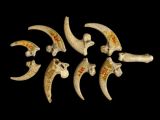Spring is in the air, the sun is shining, and the grass is almost a perfect green. Yup, time has passed, and while we've kept busy tending to our mundane affairs, scientists have been hard at work unraveling the mysteries of our little world.
For those of you who missed them because you didn't have enough time on your hands these past few days to keep an eye on the news, but also for those who feel like a recap, here are last week's most important science news and announcements.
10. Tiger dad photographed in the wild together with its family
Last week, researchers with the Wildlife Conservation Society released a video showing a tiger dad hanging out in the wild together with its sweetheart and their three cubs. The footage was obtained using camera traps set up in the Sikhote-Alin Biosphere Reserve in Russia.
As popular as these big cats are, the fact of the matter is that researchers know very little about them. In fact, the video made public by the Wildlife Conservation Society is a world first. Thus, until this footage was obtained, it was unknown that male tigers sometimes like to stay close to their family.
9. Beautifully decorated ancient tomb found in Luxor, Egypt
Just days ago, scientists working on restoring an archaeological site in the city of Luxor in Egypt accidentally came across a previously undocumented tomb estimated to date back to sometime between the 16th and the 13th century BC.
The tomb was built for a man named Sa-Mut and his wife, Ta-kh-a. Its walls are decorated with gorgeous paintings that archaeologists say are depictions of the couple. Unfortunately, evidence indicates that, several centuries back, a gang of robbers broke into the tomb and partly destroyed it.
8. Teeny tiny yet totally functional hearts grown in the lab
In a paper published in last week's issue of the journal Scientific Reports, a team of researchers explain how, by exposing them to a special cocktail of chemical compounds, they compelled human stem cells to grow into heart cells and even form tissues perfectly bound together.
When placed inside a special silicone mold, the heart tissues formed three-dimensional structures that the scientists behind these experiments say looked and behaved just like real organs. One day, such lab-made miniature organs could be used to test new drugs designed to treat various heart diseases.
7. Neanderthals were surprisingly fashionable, wore jewelry
As it turns out, Neanderthals had a keen eye for fashion. No, they didn't hold modeling contests or photo shoots. What they liked to do was to put on jewelry. Bracelets and necklaces made from claws recovered from ancient white-tailed eagles, to be more precise.
Thus, researchers say that several 130,000-year-old eagle claws found in Croatia show signs of having been polished and pierced. This indicates that, millennia ago, Neanderthals living in this corner of the world must have added them to jewelry that they probably wore for spiritual reasons.
6. Previously unknown galaxies found orbiting the Milky Way
Last week, our cosmic neighborhood welcomed as many as nine newcomers. The new arrivals, whose existence remained a mystery for decades, are a pack of dwarf galaxies that astronomers say are orbiting our home galaxy, the Milky Way.
Of the newly discovered galaxies, the closest is 95,000 light-years away and the most distant sits well over 1 million light-years away. Unlike our Milky Way, these galaxies comprise oddly few stars, i.e. an average 5,000. It is because of this that they are referred to as dwarf galaxies.
5. Homeopathy shown to be utter and complete mumbo-jumbo
In a new report, scientists working with Australia's National Health and Medical Research Council show that there is no evidence whatsoever to indicate that homeopathic remedies work. That's right, it looks like, as many already suspected, homeopathy is complete mumbo-jumbo.
The specialists behind this report say that, when a patient does feel somewhat better after having taken homeopathic remedies, this is only because of the placebo effect. What's more, they warn that those who turn to this system of alternative medicine risk getting worse by postponing actual treatment.
4. Volcano in Chile turned gray following a massive eruption
In a series of space images released just days ago, NASA scientists show how a recent massive eruption transformed Chile's Villarica volcano. The images show how, following the eruption, the mountain's slopes were covered by volcanic material and turned gray.
As detailed by geologists, the Villarica volcano erupted on March 3, in the early hours of the day. The eruption was so powerful that thousands of people living close to the mountain had to be evacuated. While erupting, the volcano sent clouds of smoke and ash about 1 kilometers (0.6 miles) high in the air.
3. “Terminator” liquid metal assassin created in the lab, sort of
While experimenting with liquid metal, a team of scientists found that, if they attached a bit of aluminum to an alloy of gallium, indium and tin, and then placed the mixture into a sodium hydroxide or even salt water solution, the resulting droplet would move on its own.
Apart from being able to get around with no external help, the liquid metal droplet proved surprisingly adaptable, meaning that it altered its shape to squeeze through narrow spaces and navigate curves. True, a droplet with a mind of its own is a far cry from a liquid metal robot assassin, but it's still something.
2. The Sun threw a fit, produced this year's first monster flare
On March 11, the Sun decided to put on a fireworks show and produced the absolute coolest and most powerful explosion since the beginning of the year until now. The event, labeled an X-class solar flare, was documented by NASA's Solar Dynamics Observatory.
Solar flares are essentially sudden and insanely powerful bursts of radiation that occur on the Surface of the Sun. Quite often, such events are accompanied by the release of massive amounts of plasma. Although they cannot harm us, solar flares can upset GPS and communication signals.
1. 10 kilowatts sent wireless over 500 meters (1,640 feet)
Last Thursday, a team of scientists employed by a Japanese company dubbed Mistubishi Heavy Industries announced the wireless transmission of 10 kilowatts over a distance of 500 meters (1,640 feet). Having reached its destination, the energy successfully fired up a handful of LED lights.
Admittedly, being able to remotely control lights would make for an awesome party trick. However, researchers have way bigger plans for this emerging technology. Long story short, they want to use wireless energy transmission to have sun power harvested in space beamed back to Earth.
The idea is to launch spacecraft in our planet's atmosphere, maybe even further up, and have them collect solar power and then wirelessly send it down to us. This would help curb our dependence on fossil fuels, maybe even make it possible to eliminate dirty energy sources altogether.
Well, there you have it. Last week's absolute best (and coolest) science news. Let's hope the next few days will prove equally entertaining and that we'll have plenty to talk about a week from now.

 14 DAY TRIAL //
14 DAY TRIAL // 









